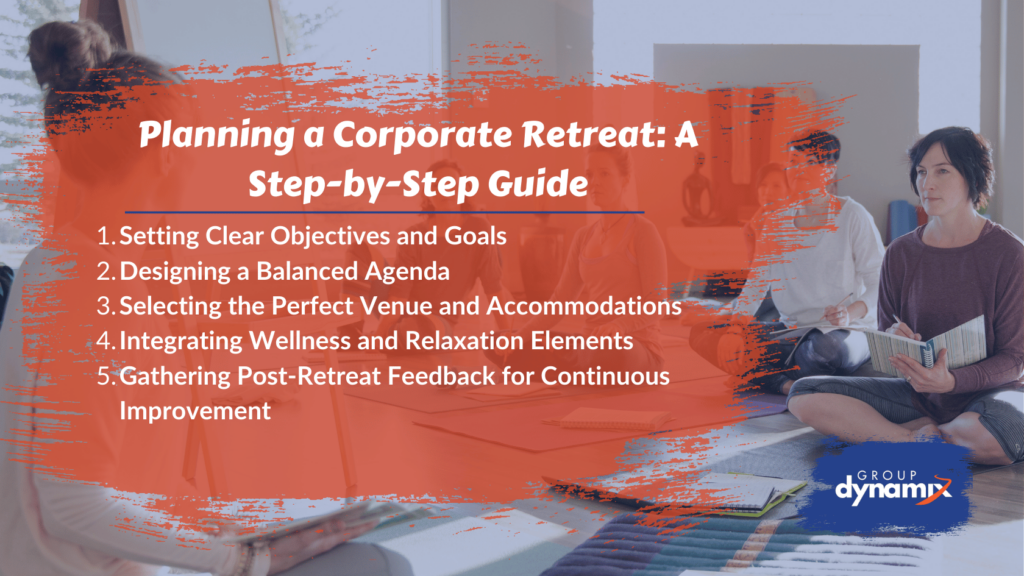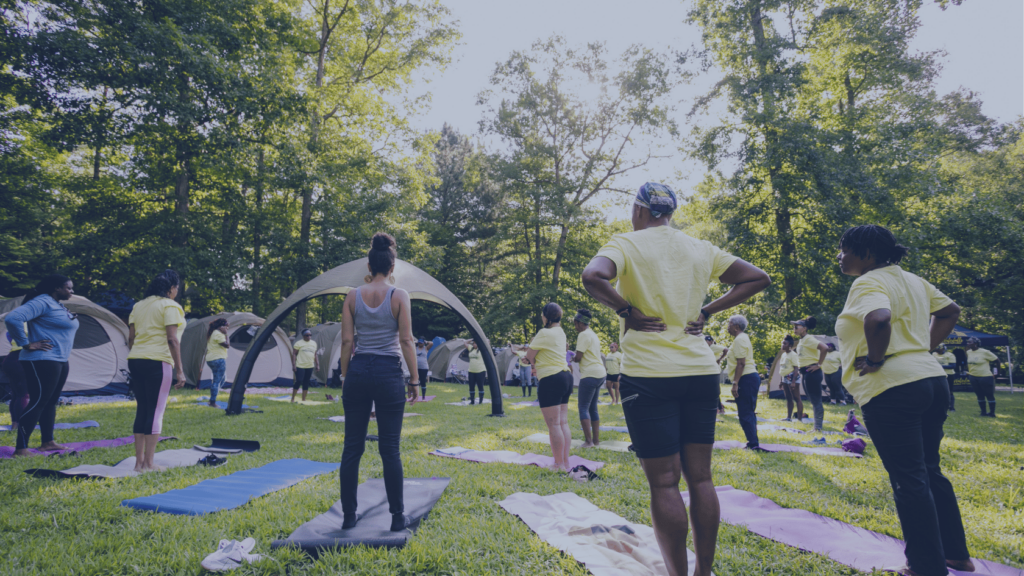Taking your team outside the office can spark creativity and build relationships in ways that regular meetings just can’t match. A corporate retreat isn’t just another expense on your books – it’s a smart investment in your company’s future, your team’s growth, and your overall success. Whether you want to get your executive team aligned on the big picture or boost everyone’s spirits, here’s your complete guide to planning a retreat that people will remember.
Ready to elevate your team’s experience? Connect with Group Dynamix today to craft the perfect retreat tailored to your needs!
Also Read:
Table of Contents

Types of Corporate Retreats: Executive vs. General
At its heart, a corporate retreat is a strategic gathering that gets people out of their usual workspace to focus on bigger goals. But not all retreats serve the same purpose – knowing the differences will help you pick the right format.
Executive retreats are smaller, focused sessions with your leadership team and key decision-makers. These meetings zero in on big-picture planning, developing leadership skills, and getting everyone on the same page about where the company’s headed. Think of them as intensive strategy sessions where tomorrow’s big decisions take shape, away from daily distractions.
General corporate retreats include folks from all levels and departments, helping break down walls between teams and build stronger connections. These gatherings are great for sparking creativity, building a stronger culture, and helping people work better together. They usually mix in more varied activities and team building exercises to keep everyone engaged.
Both types share something important: they give people a fresh environment that helps them think differently and talk more openly. Whether you’re working with your C-suite or bringing everyone together, sometimes you just need to get out of the office to have those breakthrough moments.
Benefits of Corporate Retreats: Building Stronger Teams and Cultures
As the world becomes increasingly digital-first, getting people together face-to-face has become more valuable than ever. Team building retreats create real connections that you just can’t get through Zoom calls or emails.
The benefits of a well-planned retreat last long after everyone’s back at their desks. Companies regularly see better productivity, fewer people leaving, and stronger team bonds. As Sean Hoff from Moniker puts it, “The ROI of retreats is unfortunately intangible. You’re going to see tenure. People are going to stick around longer because they’re going to like working here.”
One of the biggest wins? Breaking down communication barriers. When teams step away from their usual routines, they find it easier to share ideas and work through challenges together. This improved communication sticks around back at the office, leading to better teamwork every day.
Plus, retreats help everyone understand how they fit into the bigger picture. Through shared experiences and activities, people get a clearer sense of the company’s mission and their role in it. This creates a stronger sense of purpose and belonging, building a more motivated team that’s all pulling in the same direction.
Innovative Corporate Retreat Ideas to Inspire Your Team
Let’s explore some fresh ideas that can turn your retreat from just another business meeting into something truly memorable.
Creative Themes for Memorable Retreats
Pick a theme that sets the right tone and gets people excited. Here are some ideas that go beyond the usual:
- “Back to Nature” – Get your team thinking about sustainability and environmental impact
- “Innovation Lab” – Focus on creative thinking and future possibilities
- “Global Village” – Celebrate your team’s diversity and different perspectives
- “Wellness Warriors” – Put health, mindfulness, and work-life balance front and center
- “Impact Makers” – Mix in community service and social responsibility
Weave your chosen theme through everything from activities to meals to create a cohesive experience.
Unique Location Ideas to Enhance Experience
Where you hold your retreat can make all the difference. Consider these options:
- Eco-lodges surrounded by nature
- Historic buildings with character and stories to tell
- Beachfront spots perfect for both work and play
- Mountain retreats that inspire big thinking
- Creative spaces in artsy neighborhoods
- Working farms that connect people to nature
Exciting Indoor and Outdoor Activities
Engaging Indoor Workshops and Challenges
Mix learning with fun indoors:
- Escape rooms that get people solving problems together
- Cooking classes that build teamwork
- Innovation sessions for new product ideas
- Art workshops that spark creativity
- Skill-building masterclasses
- Interactive storytelling
- Virtual reality team challenges
Adventure-Focused Outdoor Activities
Get people moving and building trust outdoors:
- Group hikes that build camaraderie
- Team obstacle courses
- Community garden projects
- Beach competitions
- Rock climbing sessions
- Survival skills workshops
- Kayaking or rafting adventures
- Outdoor yoga and meditation
The key is picking activities that push people just enough while keeping things fun and inclusive. Mix high-energy activities with quieter moments for reflection, and always have backup plans for weather issues. The best activities help people grow both individually and as a team, creating memories that strengthen workplace relationships.

Planning a Corporate Retreat: A Step-by-Step Guide
Getting a retreat right takes careful planning and smart thinking. Here’s how to make sure your retreat delivers real value.
1. Setting Clear Objectives and Goals
Before jumping into the details, nail down what you want to achieve:
- What specific outcomes are you aiming for?
- How do these goals support your company’s bigger mission?
- How will you know if the retreat was successful?
Write these objectives down and share them with key team members to ensure everyone’s working toward the same goals.
2. Designing a Balanced Agenda
Creating a good flow takes careful thought:
- Schedule strategic work in the morning when minds are fresh
- Plan interactive activities for the afternoon
- Leave evenings open for networking and unwinding
- Include regular breaks for informal chats
Don’t pack the schedule too tight – some of the best conversations happen during downtime.
3. Selecting the Perfect Venue and Accommodations
Your choice of location can make or break the experience. Think about:
- How easy it is for everyone to get there
- Whether the meeting spaces work for your needs
- What tech setup is available
- How comfortable the rooms are
- What food options are available
- Whether there’s good outdoor space
4. Integrating Wellness and Relaxation Elements
Take care of your people’s wellbeing by including:
- Enough breaks between sessions
- Optional morning exercise or meditation
- Healthy food choices
- Quiet spots for recharging
- Relaxing evening activities
5. Gathering Post-Retreat Feedback for Continuous Improvement
Set up a good system for learning what worked:
- Send out surveys right after the retreat
- Talk to key participants one-on-one
- Watch how team dynamics change over time
- Keep notes on lessons learned
- Check results against your original goals
Look at both the immediate impact and the long-term effects on how people work together. Use what you learn to make your next retreat even better.

Practical Tips and Best Practices for Successful Retreats
Getting a retreat right comes down to the details. With corporate travel and retreat planning expected to grow in coming years, here’s what you need to know to make your retreat stand out.
Budgeting and Financial Considerations
Smart budgeting makes all the difference. With 49% of businesses increasing their travel budgets and 33% putting more money into team events, here’s what to factor in:
- What each person will cost for rooms and food
- Activity and equipment expenses
- Getting everyone there and back
- Emergency backup funds
- Fees for speakers or facilitators
- Tech needs and materials
Effective Team Building Strategies
Focus on activities that create lasting impact:
- Start with smaller challenges that build up to bigger ones
- Mix people from different departments
- Use real work scenarios for problem-solving
- Include activities that celebrate diversity
- Let team members share their expertise
- Build in time to reflect and discuss
Leveraging Technology for Seamless Organization
Use tech to make planning and execution smoother:
- Event platforms to handle scheduling
- Mobile apps to keep everyone in the loop
- Digital tools for group work
- VR experiences for something different
- Quick feedback through survey tools
- Project management software to stay organized
Customizing Retreats to Fit Company Culture
Make your retreat feel like a natural extension of your company:
- Include inside jokes and company traditions
- Design activities that connect to your industry
- Use your branding creatively
- Keep your company’s personality in mind
- Create natural opportunities for connection
- Find the right mix of professional growth and fun
Stay flexible – the best retreats often evolve naturally while keeping sight of the main goals. Focus on creating experiences that feel authentic to your team rather than following cookie-cutter plans.
Conclusion
A well-planned retreat is a powerful tool for transforming your organization. It’s not just a break from the office – it’s an investment in your company’s future that can create lasting positive change. When done right, retreats strengthen relationships, get everyone moving in the same direction, and bring fresh energy to your team. Success comes from careful planning, clear goals, and creating meaningful experiences that resonate with your people.
Look beyond just the immediate feedback to see how your retreat affects company culture, team dynamics, and overall performance over time. Whether this is your first retreat or you’re looking to improve on past events, focus on creating experiences that reflect your values while encouraging growth and connection.
Getting your team together outside the office might seem like a big investment, but the returns – in creativity, collaboration, and commitment – usually far outweigh the costs. Remember to balance structure with flexibility, work with play, and individual growth with team development.
To ensure your next retreat is a success, consider partnering with Group Dynamix. Our expertise in team-building and retreat planning can help you design an impactful experience that aligns with your goals and fosters a strong sense of community within your organization. Contact us today to learn more about how we can assist you in creating a transformative retreat experience!
FAQs and Considerations for Corporate Retreat Planning
Let’s tackle the common questions that come up when planning a retreat.
How Long Should a Retreat Last?
Retreats are getting longer, moving from three to five nights on average as companies try to make up for lost face-to-face time. While most retreats cost between $2,000 to $6,000 per person, the ideal length depends on:
- What you’re trying to achieve
- Your budget
- How many people are coming
- Where you’re holding it
- How much content you need to cover
Logistics and Legal Considerations
Don’t forget these important details:
- Getting the right insurance coverage
- Understanding what you can write off for taxes
- Having people sign waivers for activities
- Making sure facilities are accessible
- Handling food restrictions and allergies
- Taking care of international travel needs
- Having emergency plans ready
Measuring the Impact of Corporate Retreats on Team Dynamics
Look beyond just whether people had fun. Consider:
- Surveys before and after
- Team performance metrics
- How communication patterns change
- How well people work together on projects
- Whether people stick around longer
- How information flows between teams
- Whether you’re seeing more innovative ideas
Use both numbers and stories to understand your retreat’s impact. Track changes over time to see the long-term value of investing in team development.
Remember that different teams might need different ways to measure success, so adjust your approach to match your specific goals and culture.

